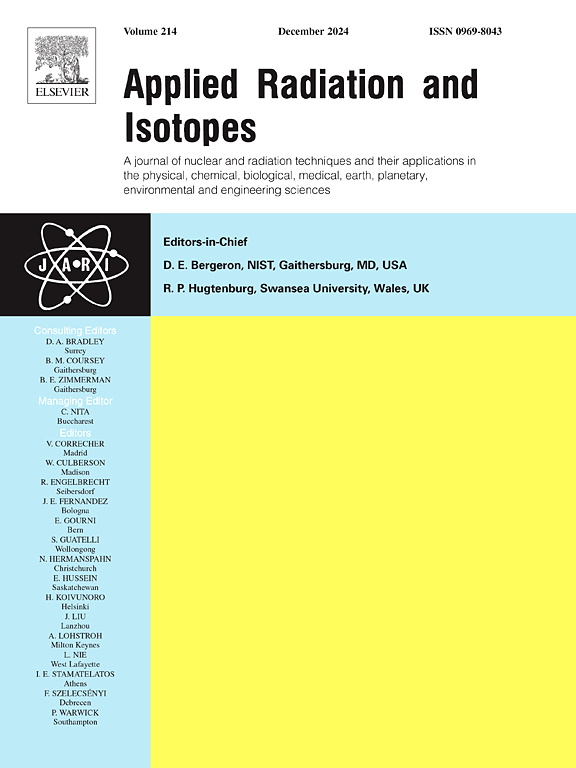DoseCV:用MRCP模型计算MCNP模拟的剂量系数
IF 1.6
3区 工程技术
Q3 CHEMISTRY, INORGANIC & NUCLEAR
引用次数: 0
摘要
近年来,计算机模型的细节水平不断提高,因此可以更可靠地再现人体。网格型参考计算幻影是ICRP第110版参考计算幻影的发展,现在可以在多边形网格中使用。使用这些幻影分析MCNP仿真结果既耗时又容易出错,因为程序生成了大量的数据。然后,本文建议创建一个名为DoseCV的软件,以帮助处理来自MCNP模拟的输出数据。使用POLY2TET工具对模型进行四面体化,使用DoseCV对输出数据进行处理。将所得结果与ICRP Publication 116的数据进行比较验证。总的来说,考虑到六种模拟能量的dc, MRCP-AF的88.9%的靶组织和MRCP-AM的76.7%的靶组织的误差小于5%。在实际版本中,DoseCV可以将统计数据转换为剂量系数(DC)、等效剂量转换系数(CC[HT])、有效剂量转换系数(CC[E])、等效剂量(HT)和有效剂量(E)。POLY2TET和DoseCV的结合使用被证明是处理MCNP模拟数据的有效工具。本文章由计算机程序翻译,如有差异,请以英文原文为准。
DoseCV: Dose coefficient calculation from MCNP simulations with MRCP phantoms
The level of detail of computer phantoms has increased over the years, thereby reproducing the human body more reliably. The Mesh-type Reference Computational Phantoms are an evolution of those from ICRP Publication 110, and are now available in polygon meshes. Analyzing MCNP simulation results using these phantoms can be time consuming and error prone due to the large amount of data generated by the program. This article then proposes the creation of a software called DoseCV to help process the output data from the MCNP simulations. The POLY2TET tool was used to tetrahedralize the phantoms, and DoseCV was used to process the output data. The results obtained were validated by comparing them with ICRP Publication 116 data. In general, considering the DCs found for the six simulated energies, an error of less than 5% was obtained for 88.9% of the target tissues of MRCP-AF and 76.7% of MRCP-AM. In its actual version, DoseCV can convert tally data into a dose coefficient (DC), equivalent dose conversion coefficient (CC[HT]), effective dose conversion coefficient (CC[E]), equivalent dose (HT), and effective dose (E). The combined use of POLY2TET and DoseCV proved to be an effective tool for processing data from the MCNP simulations.
求助全文
通过发布文献求助,成功后即可免费获取论文全文。
去求助
来源期刊

Applied Radiation and Isotopes
工程技术-核科学技术
CiteScore
3.00
自引率
12.50%
发文量
406
审稿时长
13.5 months
期刊介绍:
Applied Radiation and Isotopes provides a high quality medium for the publication of substantial, original and scientific and technological papers on the development and peaceful application of nuclear, radiation and radionuclide techniques in chemistry, physics, biochemistry, biology, medicine, security, engineering and in the earth, planetary and environmental sciences, all including dosimetry. Nuclear techniques are defined in the broadest sense and both experimental and theoretical papers are welcome. They include the development and use of α- and β-particles, X-rays and γ-rays, neutrons and other nuclear particles and radiations from all sources, including radionuclides, synchrotron sources, cyclotrons and reactors and from the natural environment.
The journal aims to publish papers with significance to an international audience, containing substantial novelty and scientific impact. The Editors reserve the rights to reject, with or without external review, papers that do not meet these criteria.
Papers dealing with radiation processing, i.e., where radiation is used to bring about a biological, chemical or physical change in a material, should be directed to our sister journal Radiation Physics and Chemistry.
 求助内容:
求助内容: 应助结果提醒方式:
应助结果提醒方式:


